
Livingston South railway station is one of two railway stations serving Livingston in West Lothian, Scotland. It is located on the Shotts Line, 14 miles (23 km) west of Edinburgh Waverley on the way to Glasgow Central. It is managed by ScotRail, who provide all train services.
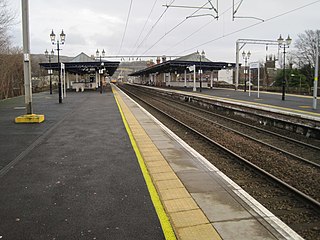
Dumbarton Central railway station serves the town of Dumbarton in West Dunbartonshire, Scotland. This station is on the West Highland Line and the North Clyde Line, 15+3⁄4 miles (25.3 km) northwest of Glasgow Queen Street.

Kirkhill railway station is a railway station serving the Kirkhill area of the town of Cambuslang, South Lanarkshire, Greater Glasgow, Scotland. The station is managed by ScotRail and is located on the Cathcart Circle Lines. This is the least used station on the Newton Branch.
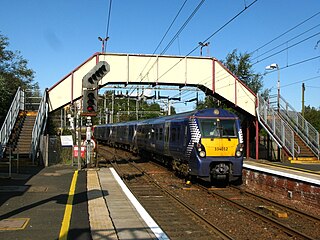
Dalreoch railway station serves the west end of Dumbarton in West Dunbartonshire, Scotland. The station is managed and served by ScotRail and is served by trains on the North Clyde Line. The station is 16 miles 38 chains (26.5 km) northwest of Glasgow Queen Street, measured via Singer and Maryhill.

Dumbarton East railway station serves the town of Dumbarton in the West Dunbartonshire region of Scotland. The station is managed by ScotRail and is served by trains on the North Clyde Line, 15 miles (24 km) west of Glasgow Queen Street.

Bowling railway station serves the village of Bowling in the West Dunbartonshire region of Scotland. This station is on the North Clyde Line, between Kilpatrick and Dumbarton East, 12 miles 70 chains (20.7 km) from Glasgow Queen Street measured via Maryhill. The station is managed by ScotRail who provide all train services.

Easterhouse railway station serves the Easterhouse area of Glasgow, Scotland. It was built by the North British Railway as part of their Coatbridge Branch and opened when the branch opened on 1 February 1871. The station is 5¾ miles (9 km) east of Glasgow Queen Street railway station on the North Clyde Line and is managed by ScotRail.
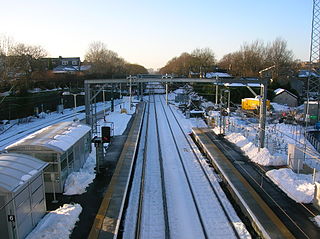
Airdrie railway station is a railway station serving the town of Airdrie, North Lanarkshire, Scotland. The station is managed by ScotRail and is served by trains on the North Clyde Line, 11 miles (18 km) east of Glasgow Queen Street.
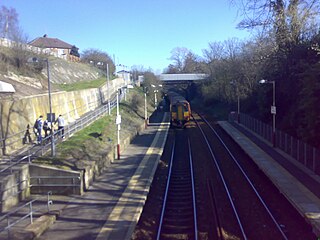
Clarkston railway station is a suburban side platform railway station in the town of Clarkston, East Renfrewshire, Scotland. The station is managed by ScotRail and is on the East Kilbride branch of the Glasgow South Western Line. It was opened in 1866 by the Busby Railway.

Partick Central railway station was a station serving the Partick area of the city of Glasgow. Built in the 1890s by the Lanarkshire and Dunbartonshire Railway Company, it sat on a line that ran along the north bank of the River Clyde from Stobcross to Dumbarton.
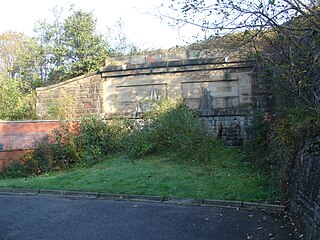
Maryhill Central was a railway station to the north west of Glasgow.

Kelvinside railway station was located on Great Western Road, next to the current Gartnavel General Hospital in the Kelvinside area of Glasgow, Scotland. Part of the Lanarkshire and Dunbartonshire Railway services ran through the station from Glasgow city centre to Maryhill in the north of the city and beyond. The line from the station to Crow Road railway station passes under the current site of Hyndland railway station on the Argyle and North Clyde lines.

Crow Road railway station was located in Glasgow, Scotland and served the Broomhill and Hyndland areas of that city.

Possil railway station was situated on Balmore Road, in the north of Glasgow, Scotland and served the Possilpark and Parkhouse areas of the city.
The Bathgate and Coatbridge Railway, also known as the "New Monkland Line", was built by Monkland Railways. It opened on 28 July 1863. The line was absorbed into the Edinburgh and Glasgow Railway on 31 July 1865. The following day, the line became part of the North British Railway.
Cleland and Midcalder Line is a historic railway line in Scotland. Built by the Caledonian Railway and opened in 1869, it provides a link between Glasgow and Edinburgh through the mining communities of Lanarkshire and West Lothian.

Elvanfoot railway station was a station which served Elvanfoot, in the Scottish county of South Lanarkshire. It was served by local trains on what is now known as the West Coast Main Line.

Crawford railway station was a station which served the village of Crawford, near Abington, in the Scottish county of South Lanarkshire. It was served by local trains on what is now known as the West Coast Main Line.

Whiteinch Riverside railway station served the Whiteinch area of the city of Glasgow. It was a two platform station on the Lanarkshire and Dunbartonshire Railway.
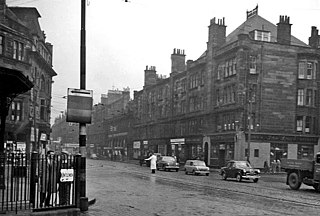
Bridgeton Central railway station was located in Glasgow, Scotland and served the Bridgeton area of that city. On the Glasgow City and District Railway it was located on the modern North Clyde line on a branch from High Street and acted as a terminus for services from the north west of the city.






















